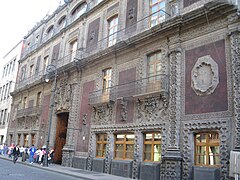Palace of Iturbide
This article needs additional citations for verification. (June 2016) |
| Palace of Iturbide | |
|---|---|
Palacio de Iturbide | |
 Facade of Palace of Iturbide | |
 | |
| Alternative names | Palace of the Counts of San Mateo de Valparaiso and Marquises of Jaral de Berio |
| Etymology | Agustín de Iturbide |
| General information | |
| Architectural style | New Spanish Baroque |
| Construction started | 1779 |
| Completed | 1785 |
| Design and construction | |
| Architect | Francisco Antonio Guerrero y Torres |
The Palace of Iturbide (1779 to 1785) is a large palatial residence located in the historic center of Mexico City at Madero Street #17. It was built by the Count of San Mateo Valparaíso as a wedding gift for his daughter. It gained the name “Palace of Iturbide” because Agustín de Iturbide lived there and accepted the crown of the First Mexican Empire (as Agustin I) at the palace after independence from Spain. Today, the restored building houses the Fomento Cultural Banamex; it has been renamed the Palacio de Cultura Banamex.
History of the building[]
This residence was constructed by Miguel de Berrio y Saldívar, Count of San Mateo Valparaíso and Marquis of Jaral de Berrio. Berrio y Saldívar's fortune was based in mining and livestock. He also served as the mayor of Mexico City. He purportedly built the palace in an elaborate way to equal the sum of his daughter's dowry,[1] approximately 100,000 pesos,[2] in order to stop his new son-in-law, the Marquis of Moncada of Sicily, from squandering his daughter's wealth. It was built as a replica of the royal palace of Palermo. This couple's son, the grandson of the home's builder, preferred not to live in the palace but offered it for the use of visiting dignitaries, such as viceroy Félix Calleja and later Agustín de Iturbide. From this palace's balcony, Iturbide accepted the offer to be Mexico's first emperor after independence from Spain. During his reign (1821–1823), he lived here, using the house as the royal palace.[2]
After the Conquest, the site had been part of land granted by the Spanish Crown to Gonzalo Juárez de Córdoba.[3] Until the 17th century, the site was a convent for the Sisters of Saint Brigit, until they sold the land to Berrio y Saldívar.[4]
Design of the building[]


This Mexican Baroque building was designed and begun by Francisco Antonio Guerrero y Torres and finished by his brother-in-law Agustín Duran between 1779 and 1785.[1][5] The building has three floors and a mezzanine, showing Italian influence in its Baroque design. Its façade of tezontle and cantera stone[6] is flanked by two fortified towers at the ends of the façade. It has a central gallery or loggia, which is now closed to the public. The façade is decorated with carved stone that features organic and geometric motifs such as flowers, small double-tailed mermaids and graceful male figures. Inside, the porch has a vaulted roof.[1]
A large archway leads to the courtyard decorated with geometric figures.[1] The courtyard is surrounded by eighteen arches supported by Tuscan columns.[6]
Later uses of the building[]
Early in the 19th century, the building housed the . It was remodeled in 1855 for use as a hotel, serving that function for more than 100 years.
In 1965, the building was purchased and restored by the National Bank of Mexico. In 1972, it became the home of the Banamex Cultural Foundation (Fomento Cultural Banamex).[5]
The foundation spent two years from 2002 to 2004 doing significant restoration work on the building. It reopened the structure for use as the “Palacio de Cultura Banamex.” It hosts numerous temporary art exhibitions, as well as art workshops for adults and children.[5]
References[]
- ^ Jump up to: a b c d Galindo, Carmen; Galindo, Magdalena (2002). Mexico City Historic Center. Ediciones Nueva Guia. pp. 127–128. ISBN 968-5437-29-7.
- ^ Jump up to: a b Tercero, Magali (1998). Palacios de la Nueva España (in Spanish and English). Artes de Mexico. pp. 85–85. ISBN 968-6533-61-3.
- ^ "Museo Palacio Cultural Banamex (Antiguo Palacio de Iturbide)". Retrieved 2009-03-23.
- ^ "Antiguo Palacio de Iturbide". Archived from the original on 2008-12-23. Retrieved 2009-03-23.
- ^ Jump up to: a b c "Palacio de Cultura Banamex". Archived from the original on January 8, 2008. Retrieved 2009-03-23.
- ^ Jump up to: a b "El palacio de Iturbide (Distrito Federal)". Mexico Desconocido. October 2004. Retrieved 2009-03-23.
| Wikimedia Commons has media related to Palace of Iturbide. |
Coordinates: 19°26′1.55″N 99°8′19.92″W / 19.4337639°N 99.1388667°W
- Palaces in Mexico
- Baroque palaces
- Houses in Mexico City
- Museums in Mexico City
- Art museums and galleries in Mexico
- Contemporary art galleries in Mexico
- Historic house museums in Mexico
- Historic center of Mexico City
- Imperial residences in Mexico
- Royal residences in Mexico
- Mexican monarchy
- Landmarks in Mexico City
- History of Mexico City
- Houses completed in 1785
- 1785 establishments in Mexico
- Museums established in 1972
- 1972 establishments in Mexico
- Mexican War of Independence
- Baroque architecture in Mexico
- Spanish Colonial architecture in Mexico
